Rodents are a nuisance anywhere in the world. However, when these rodents become bigger in size and start destroying everything in sight, they become an issue you must mitigate. The same goes for the rodents in North Carolina. While many rodents are helpful for the environment in the state, there are others that people are trying to escape. These rodents are invading homes, causing hygienic issues, and bothering the homemakers. In this blog post, we will study the characteristics of a rodent to understand how they differ from other species. Moreover, you will find whether rodents are a dangerous species to humans and which of these rodents have been troubling the state of North Carolina. So, let’s start right away.

What Is A Rodent?
The term “rodent” has a Latin origin and comes from the word rodere. It means “to gnaw,” which is a primary characteristic of rodents.
Rodents belong to the Kingdom of Mammalia and are of the Order Rodentia. The term rodents might take you to rats and mice, but there are around 2000 rodent species worldwide. It is a vast group of animals with certain habits that makes them a rodent.
The interesting thing about rodents is that they are present all over the world, except Antarctica, and make up to 43% of the world’s mammalian population. You will find them not only as pests but also embracing solitude in isolated environments. Some of the common rodents apart from rats and mice are Squirrels, Dormice, Gerbils, Beavers, Gophers, Kangaroo rats, Porcupines, Lemming, Chinchilla, Hamsters, and many more.
Characteristics of a Rodent
Some of the main characteristics that make a rodent a typical rodent are as follows.
- They are a type of mammal whose body is covered with hair.
- The main body part that distinguishes them from others is their teeth. They have large incisors that are separated from their molars by a significant gap. They come in a pair and are present both in the upper and lower jaws. These incisors are known for gnawing and chewing with force and act as their primary weapon for food. Moreover, these powerful incisors often keep growing continuously in size for all rodent species.
- They give birth to young, which are produced in a large litter. Each litter may carry 4 to 6 young, and the number of litters per year may vary with each species. However, this number can climb up to 12 litters per year.
- They often have smaller bodies capable of running fast and have long tails.
- They have a neophobic nature where they are afraid of a new environment. It is a defense mechanism often found in rats.
Are Rodents Dangerous To Humans?
No, not all rodents are dangerous to humans. You might think this because mostly mice and rats are the most popular rodents we know about. However, the rest of the rodent species present all over the world are usually no danger to humans.
Some squirrels help in seed dispersal, muskrats create a habitat for waterfowl, and beavers constitute an important part of the ecosystem by creating dams.
However, if you do spot a rat, a mouse, or a similar rodent in your house, you should call the local pest services to remove them. They carry a huge number of diseases and can be harmful to people of all ages.
One thing to note is that rodents are often not aggressive. Even if they do bite a human, it is because they are trying to defend themselves. Some of them do carry a large number of health risks, but they are not aggressive by nature.
Why Are Rodents So Destructive In North Carolina?
Some of the rodents can be destructive anywhere they set foot. Let’s take a tour of their habitual patterns to see how they can harm your household.
They enter the house through basements or windowpanes by gnawing at the bottom of the doors. You might even see them climbing the trees to jump into reachable spots in a house. They can slither through small holes or make big holes around your house to pave their way inside.
In their aim to find the food, they will destroy anything they set their eyes on. From chewing on wires and walls to gnawing through baseboards and insulation, they can ruin the interior of the house without you knowing about it. Most of all, they will eat and contaminate the food that is placed within their reach. You will later find these food items chewed upon or lying on the floors of your house.
In addition to all of this, their droppings are one of the biggest health hazards for a human. Not only is the stench horrible, but it can also contaminate the atmosphere of your home. They also reproduce quickly. So, if you leave them in the house for long, you won’t just have one rodent to remove but a whole litter to be concerned about.
6 Rodents Causing Chaos In North Carolina
There are many rodent species in North Carolina because of its diverse atmosphere. However, some of the most common rodents you will find destroying the peace of the people in the state are mentioned below.
1. Nutria
Nutria is semi-aquatic rodents that come from South America. However, recently they have migrated to the Northern side of America. They can weigh up to 30 to 40 pounds and maintain their habitat closer to freshwater.
They have a powerfully extensive eating capability. You will find them eating the vegetation up until the roots become visible. Their semi-aquatic nature allows them to stay inside water for around 5 minutes. They are social, nocturnal, and heavy breeders. Sometimes, they might become active during the day, but it mostly depends on the season.
Apart from being herbivorous, they may occasionally hunt for snails and mussels. They reproduce fast by producing 2 to 8 young per litter. The number of litter may be 3 in a year. These rodents have recently taken hostage in the banks of North Carolina, destroying vegetation as fast as they can gnaw on it. Their powerful incisors pave their way further into the plants, allowing easy destruction of the plants in sight.
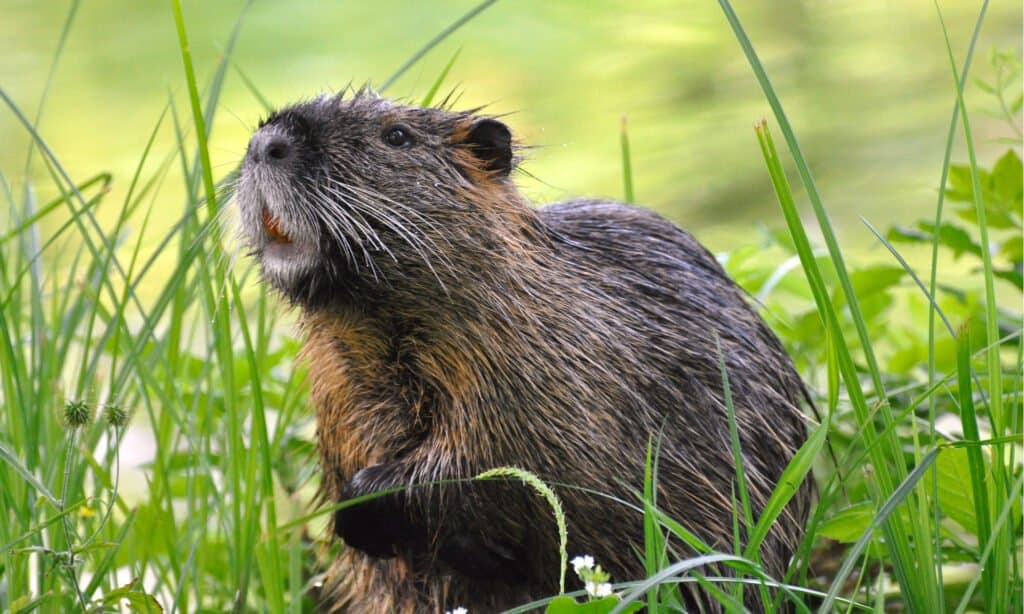
Nutrias are known for their orange-stained front teeth.
©Sonja Guijarro/Shutterstock.com
2. Groundhogs
Groundhogs are around 16 to 26 inches long. They have small, hairy bodies but are robust with their movements. You can identify them from their hairy bodies, which are normally dark brown but with a silvery touch. In addition, they have white-colored tips at the end of their hair, giving them this silvery appearance.
They are known to build dens. Depending upon the season, their dens will have different purposes. Usually, in the winter season, these dens serve as a protective cover as they go into hibernation mode for the whole season. In summer, their dens are found near agricultural sources and vegetation to help them with the necessary nutrition.
However, this aspect of them is what makes these rodents trouble around town. They borrow tunnels near the food source, which is usually around the agricultural lands. As a result, farmers and houses with gardens suffer a lot. Most of all, their tunneling ruins the vegetation within minutes.
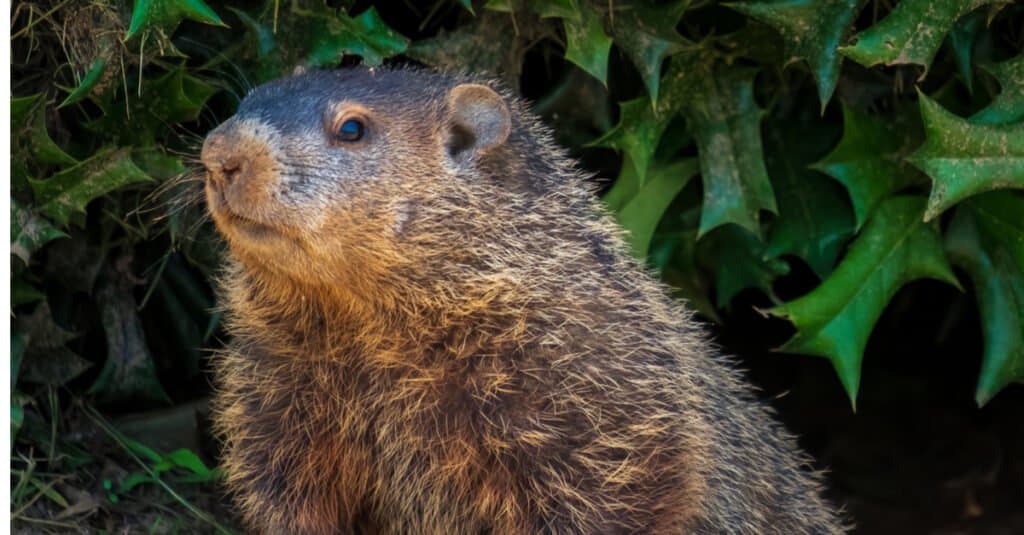
Groundhogs have white-colored tips at the end of their hair, giving them this silvery appearance.
©samray/Shutterstock.com
3. Norway Rats
Norway rats are around 10 inches long on average. However, their normal size can vary from 7 to 16 inches which is quite large compared with the average rat. Plus, they have the tendency to grow and become heavier as they gnaw on the food they are after. However, with heavy bodies, they cannot climb on top of surfaces, which is why they prefer staying on the ground.
They go by many names, the “sewer rat,” “brown rat,” and even a “wharf rat.” Moreover, they are aquatic, so they can stay underwater for a brief amount of time, making them even more dangerous.
The thing about these rats is that they can consume anything. They are always after their next meal, which is why they prefer nesting near the food source. Specifically, a place where they can get food without climbing. This is why you will find them in the basements most of the time. Their favorite habitat is a sweet home where they can stay warm and get the food they need whenever they want, making them dangerous rodents for humans.
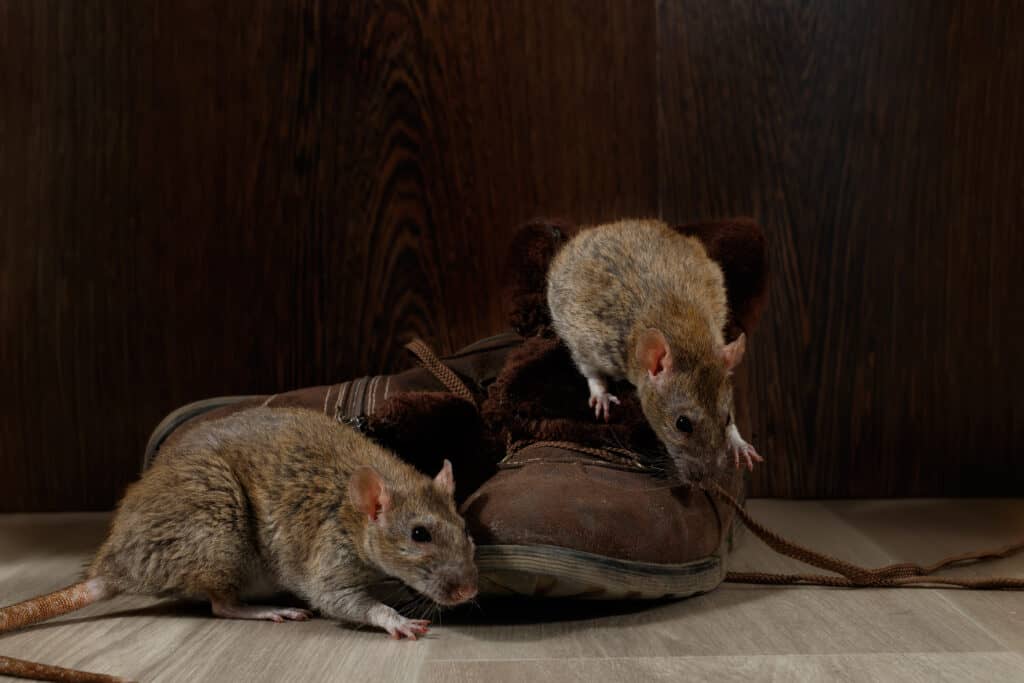
If they have the chance, Norway rats will live in groups growing to hundreds of members, called colonies.
©torook/Shutterstock.com
4. Roof Rats
As you can determine from their names, the roof rats are what you will hear scurrying in the ceilings. They are quite the climbers and can easily get on top of surfaces without a hassle. Plus, their bodies are smaller, around 7 inches long, which makes them fast in their movements.
They are also called “black rats” and can infest a home by residing in tunnels and holes. Their way of destruction is similar to the normal rats as they can pioneer their way through wall insulations, basement boards, and even rooflines. However, their nesting area may differ as they might also reside in gutters.
You will find them on the hunt for food around the house, but they won’t be nesting in close proximity to the food source. They are climbers, which makes it easy for them to go around on the hunt rather than staying in one place. Moreover, they often leave feces and urine around, which makes them a health hazard for humans. Normally, they tend to stay indoors but can also make quite the hassle outdoors too by creating nesting areas in fences, trees, and even near furniture.
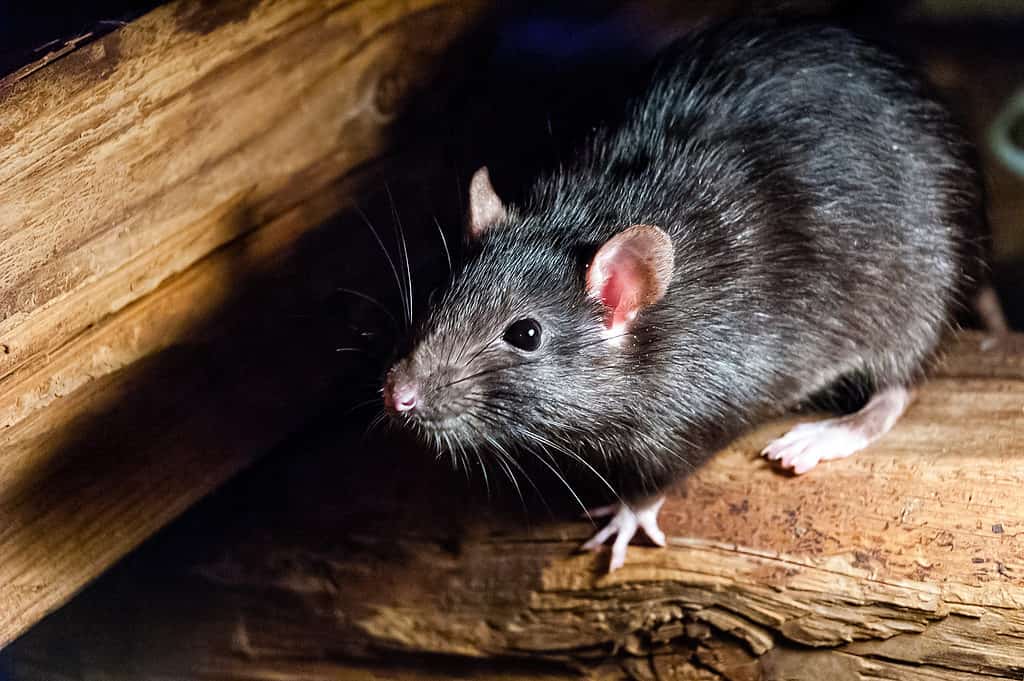
Roof rats also called “black rats,” and can infest a home by residing in tunnels and holes.
©Carlos Aranguiz/Shutterstock.com
5. Grey Squirrels
You might not think of grey squirrels as dangerous rodents because they aren’t one until they infest a house. However, they can seep through the holes and tunnels of a house and chop through the wires and boards with their powerful incisors. Plus, they are very small, which makes them a hard catch unless you have professional services by your side.
Grey squirrels’ size is up to 1.5 inches in diameter and around 16 to 20 inches in length. This small size allows them to get through the interior of the house, even through ventilation and exhaust fans. Their nesting areas are usually near the trees.
Their behavior is usually to hoard food. So, they get on the hunt and find the food source but scurry along and take it back to their safe space. If you do find them, you will find them running around the house, which is why they are harder to catch.

Grey squirrels can seep through the holes and tunnels of a house and chop through the wires and boards.
©Bruce MacQueen/Shutterstock.com
6. Voles
Voles are typically a type of mice and are usually known as “field mice.” They are very small, ranging from 3 to 7 inches in length. They do not infest homes as much as the other rodents on the list, but they can infest your gardens.
This is the reason that voles are a destructive rodent for humans because of their tunneling behavior. They prefer to stay underground, which forces them to borrow tunnels in gardens. This is why they are quite hard to remove and catch unless professional services are involved.
You will often find your vegetation and gardens destroyed by these menacing rodents. Moreover, they reproduce fast. They are known to produce around 100 babies a year!
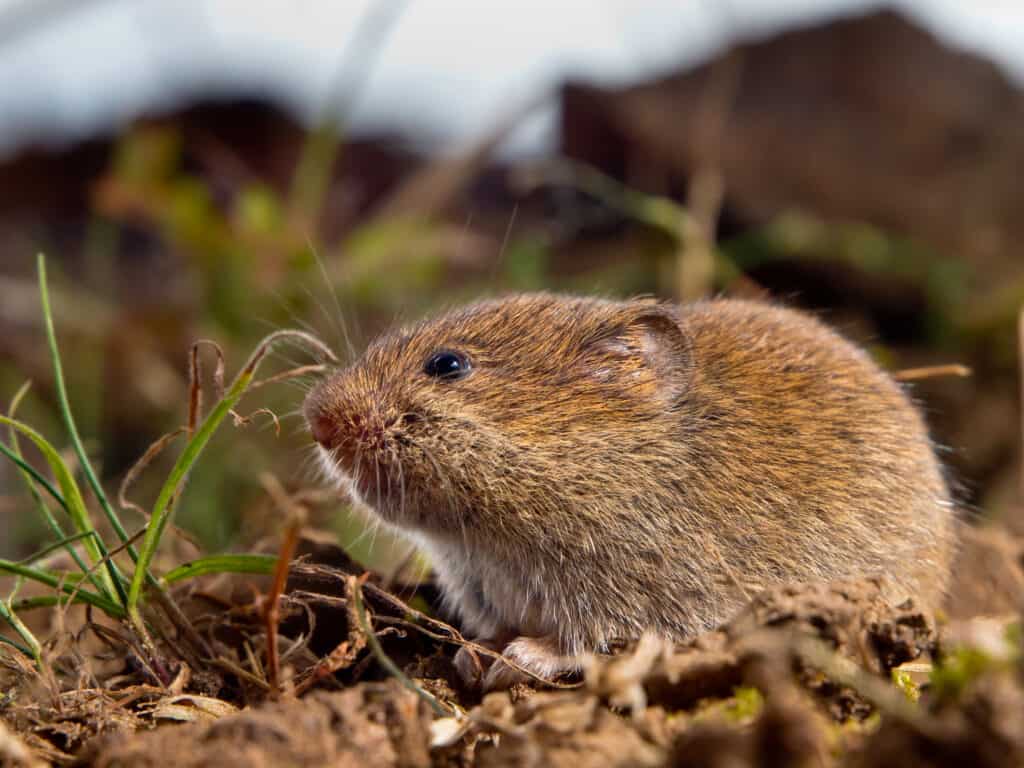
Voles do not infest homes as much as the other rodents on the list, but they can infest your gardens.
©iStock.com/CreativeNature_nl
Key Takeaways
Those are the main rodents that are running wild in North Carolina.
While some of them may look cute and cuddly, they can really cause major damage to their environment. There are many ways to get rid of rodents depending on the type and where they are living. So be on the lookout for any signs of them in or around your home, especially in North Carolina!
Summary Of 6 Destructive Rodents Running Wild In North Carolina
| Rank | Destructive Rodent |
|---|---|
| 1 | Nutria |
| 2 | Groundhog |
| 3 | Norway Rat |
| 4 | Roof Rat |
| 5 | Grey Squirrel |
| 6 | Voles |
The photo featured at the top of this post is © Agnieszka Bacal/Shutterstock.com
Thank you for reading! Have some feedback for us? Contact the AZ Animals editorial team.






